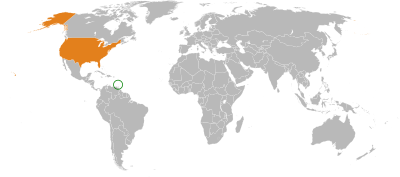Grenada: Difference between revisions
Pat Palmer (talk | contribs) (adding a map showing Grenada's relative location) |
Pat Palmer (talk | contribs) mNo edit summary |
||
| Line 2: | Line 2: | ||
{{Image|Grenada USA Locator.svg|right|400px|Location of the island of Grenada relative to the [[United States of America|U.S.A.]].}} | {{Image|Grenada USA Locator.svg|right|400px|Location of the island of Grenada relative to the [[United States of America|U.S.A.]].}} | ||
'''Granada''' is an island democracy located at the southern end of the Windward Islands region of the Caribbean Sea. Consisting of Grenada and six smaller islets, the nation forms part of the Grenadines island chain. The island is volcanic in origin with fertile soils and has earned the nickname 'Island of Spice' due to the volume of spices such as nutmeg exported. | '''Granada''' is an island democracy located at the southern end of the Windward Islands region of the Caribbean Sea. Consisting of Grenada and six smaller islets, the nation forms part of the Grenadines island chain. The island is volcanic in origin with fertile soils and has earned the nickname 'Island of Spice' due to the volume of spices such as nutmeg exported. | ||
The island's first settlers were Arawaks, who were later driven out by the Caribs. Christopher Columbus sighted Grenada in 1498, giving it its present day name. The [[England|English]] attempted to colonise the island in 1609 but were unsuccessful, and it wasn't until 1649 that the [[French]] were able to establish a settlement at St. Georges Harbour. Grenada was ceded to [[British Empire|Britain]] following the Treaty of Paris in 1763, but was briefly occupied by the French military during the [[American Revolutionary War]] until the 1783 Treaty of Versailles. | |||
Grenada was declared a British Crown Colony in 1877 and granted full independence in 1974. | |||
Following a coup which deposed its prime minister Maurice Bishop in 1983, the Organization of American States requested the [[United States of America]] to [[Grenada invasion (U.S.A., 1983)|intervene and restore democracy]]. | Following a coup which deposed its prime minister Maurice Bishop in 1983, the Organization of American States requested the [[United States of America]] to [[Grenada invasion (U.S.A., 1983)|intervene and restore democracy]]. | ||
The capital and largest city is St. George's, and the estimated island population in 2012 was 109,590. | The capital and largest city is St. George's, and the estimated island population in 2012 was 109,590. | ||
Revision as of 11:18, 3 December 2023

Granada is an island democracy located at the southern end of the Windward Islands region of the Caribbean Sea. Consisting of Grenada and six smaller islets, the nation forms part of the Grenadines island chain. The island is volcanic in origin with fertile soils and has earned the nickname 'Island of Spice' due to the volume of spices such as nutmeg exported.
The island's first settlers were Arawaks, who were later driven out by the Caribs. Christopher Columbus sighted Grenada in 1498, giving it its present day name. The English attempted to colonise the island in 1609 but were unsuccessful, and it wasn't until 1649 that the French were able to establish a settlement at St. Georges Harbour. Grenada was ceded to Britain following the Treaty of Paris in 1763, but was briefly occupied by the French military during the American Revolutionary War until the 1783 Treaty of Versailles.
Grenada was declared a British Crown Colony in 1877 and granted full independence in 1974.
Following a coup which deposed its prime minister Maurice Bishop in 1983, the Organization of American States requested the United States of America to intervene and restore democracy.
The capital and largest city is St. George's, and the estimated island population in 2012 was 109,590.